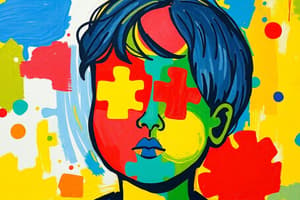Podcast
Questions and Answers
What is Autism Spectrum Disorder (ASD)?
What is Autism Spectrum Disorder (ASD)?
- A developmental disorder (correct)
- A mental illness
- A physical disability
- A mood disorder
What are the three core features of ASD?
What are the three core features of ASD?
Social Difficulties, Communication Abnormalities, Repetitive Behavior and Narrow Interests
Social difficulties in autism include a lack of eye contact.
Social difficulties in autism include a lack of eye contact.
True (A)
What is echolalic speech?
What is echolalic speech?
What percentage of individuals with ASD show unusual abilities?
What percentage of individuals with ASD show unusual abilities?
Boys are at higher risk for autism than girls. What is the approximate ASD sex ratio?
Boys are at higher risk for autism than girls. What is the approximate ASD sex ratio?
What is the mindblindness theory?
What is the mindblindness theory?
What has been identified as a cause of ASD according to the genetic factors evidence?
What has been identified as a cause of ASD according to the genetic factors evidence?
Executive dysfunction theory suggests that autistic individuals have difficulties in _____ action.
Executive dysfunction theory suggests that autistic individuals have difficulties in _____ action.
What types of therapies are important for individuals with ASD?
What types of therapies are important for individuals with ASD?
There is a clear medical intervention that demonstrates benefits for social or communication symptoms in ASDs.
There is a clear medical intervention that demonstrates benefits for social or communication symptoms in ASDs.
Flashcards are hidden until you start studying
Study Notes
Autism Overview
- Autism is a neurodevelopmental disorder characterized by a wide range of symptoms and co-occurring diagnoses.
- Autism is a spectrum disorder, meaning its severity and impact on development vary greatly among individuals.
- Common delays in autism include difficulties in social relations and language.
Autism Spectrum Disorder (ASD)
- DSM-V consolidates previous diagnoses into ASD, unlike DSM-IV which differentiated between autism types (Asperger syndrome, classic autism, atypical autism).
- Asperger syndrome indicates normal IQ with no language delay, while classic autism typically entails severe challenges, including language delays.
Core Features of ASD
- Core features include social difficulties, communication abnormalities, and repetitive behaviors with narrow interests.
Social Difficulties
- Individuals with autism may show extreme disinterest in social interactions.
- Common behaviors include minimal eye contact, a preference for solitude, and challenges in perceiving emotional cues from others.
Communication Abnormalities
- Echolalia (repeating words or phrases) and literal interpretations of language are common.
- There can be varying degrees of language delay and inappropriate usage of speech.
Repetitive Behavior and Narrow Interests
- Repetitive actions include hand-flapping, body spinning, and organizing or collecting objects.
- Individuals may also display a strong need for sameness and can struggle with change.
Autistic Savants
- Approximately 0.5% to 10% of individuals with ASD exhibit exceptional abilities, often portrayed in media.
- Notable example: Stephen Wiltshire, who can recreate entire cityscapes from memory.
Prevalence of Autism
- Recent studies indicate about 1.1% of the adult population may have ASD.
- The prevalence of reported cases has increased since the 1990s, with a higher risk for boys (ratio approximately 4:1 compared to girls).
Diagnosis of Autism
- Diagnoses typically conducted by trained psychiatrists or psychologists.
- Classic autism can be identified as early as 18 months, whereas other forms often diagnosed later.
- Diagnosis aims to facilitate access to support, despite potential stigma.
Psychological Theories of Autism
- Theories include executive dysfunction, weak central coherence, mindblindness, and the empathizing-systemizing theory, each providing insights into cognitive and behavioral traits associated with ASD.
Executive Dysfunction Theory
- Linked to underdevelopment of the prefrontal cortex, impacting planning and attention-shifting abilities.
- Explains behaviors such as repetitive actions and the focus on narrow interests.
Weak Central Coherence
- Individuals may struggle to integrate information, focusing on minute details rather than the overall picture.
- This can enhance memory for specifics but hinder holistic understanding.
Mindblindness Theory
- Reflects challenges in developing a Theory of Mind, leading to difficulties in social interactions and understanding others' perspectives.
Empathizing-Systemizing Theory
- Suggests delayed empathy combined with enhanced systemizing skills; systemizing involves analyzing and constructing systems by recognizing rules and patterns.
Biology of Autism
- Autism is classified as a neurodevelopmental disorder, influenced by atypical brain development.
- Differences noted in structures like the amygdala, hippocampus, and cerebellum, often smaller in individuals with autism.
Genetic Factors in Autism
- Autism is heritable, with twin studies showing a higher concordance rate in monozygotic (60-90%) versus dizygotic twins (5-10%).
- Family studies indicate increased likelihood of ASD occurrence among siblings.
Causes and Theories
- Multiple theories about autism’s origins exist, but no definitive causal factors have been established.
- Misleading and inaccurate information about the disorder is prevalent online.
Interventions for Autism
- Various therapies exist, including medication (e.g., antipsychotics) to manage behavior; however, these do not directly address social and communication symptoms.
- Early intensive interventions can enhance cognitive and language skills, while parent training and CBT may improve social abilities.
Challenges in Intervention
- Limited evidence on the effectiveness of many behavioral therapies and lack of rigorous study methodologies hinder understanding of effective treatments.
- There is a need for larger and better-characterized studies to develop targeted intervention plans for children with autism.
Studying That Suits You
Use AI to generate personalized quizzes and flashcards to suit your learning preferences.




